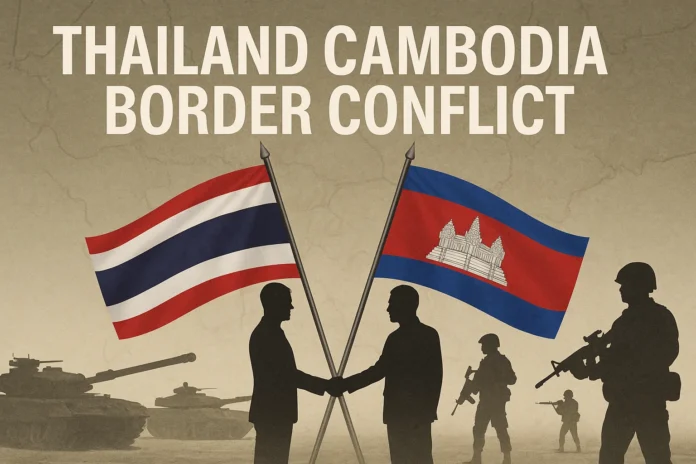Thailand Cambodia Border Conflict: Introduction
In a volatile development following a fragile truce agreement, Thailand has accused Cambodia of violating a ceasefire barely hours after it was declared. Amid new accusations and rebuttals, the ceasefire that was supposed to provide respite from five days of fierce fighting along the disputed border is now in danger of breaking down.
Accusations and Denials Emerge After Midnight Calm
The Thai military stated that while its forces ceased operations after midnight, gunfire from the Cambodian side resumed at multiple locations on Tuesday morning, suggesting a breach of the agreement. Thailand asserts that its troops were targeted despite standing down in compliance with the deal struck on Monday.
The defense ministry of Cambodia, however, vehemently denied the allegations, saying AFP that there had been “no armed clashes” since the ceasefire was established. This sharp divergence in narratives underscores the fragile trust that continues to hamper progress toward lasting peace.
Truce Agreement and Commanders’ Meet
Despite the tension, a key element of the agreement—a meeting between local military commanders—did take place on Tuesday as scheduled. In the discussion, both sides reportedly reaffirmed their commitment to halting troop movement and hostilities. They also agreed to facilitate the retrieval of bodies from the battlefield, a grim reminder of the human cost of the conflict.
Decades-Old Dispute Reignites
The latest hostilities are rooted in a long-standing border dispute, particularly over a centuries-old temple situated in the contested area. While tension has flared sporadically over the years, the latest escalation began in May when a Cambodian soldier died in a skirmish. Matters worsened after five Thai soldiers were injured by a landmine, prompting Thailand to shut border crossings, expel Cambodia’s ambassador, and recall its own envoy from Phnom Penh.
What followed was a cascade of violence, with Cambodia launching rockets into Thai territory—killing civilians—and both nations ramping up retaliatory attacks. Thousands of civilians fled their homes, with emergency shelters struggling to accommodate the displaced.
Political Push for Peace Under Pressure
Amid international concern, a ceasefire was finally brokered during a high-level meeting in Malaysia, hosted by Malaysian Prime Minister Anwar Ibrahim. Cambodia’s Prime Minister Hun Manet expressed optimism, calling it a “very good meeting,” while Thai Prime Minister Phumtham Wechayachai joined the talks reluctantly, reportedly under U.S. pressure. President Donald Trump had warned Thailand that trade negotiations would be halted unless the violence stopped—an unusual geopolitical twist that spurred diplomatic urgency.
Ceasefire Terms and Monitoring Challenges
The ceasefire, though now contested, requires both countries to withdraw troops from the frontlines and allow for third-party monitoring to prevent renewed clashes. The extent of that monitoring, and who will oversee it, remains uncertain—a critical gap that may jeopardize enforcement and transparency.
Cambodia, often viewed as the militarily weaker party, had long pushed for a truce. Observers note that while Thailand had more leverage in terms of firepower and economic sanctions, international diplomacy played a decisive role in bringing the two sides to the negotiating table.
History of Flare-Ups and Cultural Flashpoints
The roots of the Thai-Cambodian border conflict can be traced back to 2008, when Cambodia sought UNESCO recognition for the Preah Vihear Temple—an 11th-century site located within a disputed zone. The move ignited nationalistic fervor in Thailand, leading to a decade of intermittent clashes, particularly in areas where territorial demarcation remains unclear.
Over the years, these confrontations have not only claimed the lives of soldiers but also innocent civilians caught in the crossfire. More recently, the diplomatic rift has taken a toll on bilateral trade, as both countries imposed economic restrictions and border controls, including bans on food, electricity, and internet exchanges.
Outlook: Fragile Peace or Renewed Hostilities?
As Tuesday unfolded with conflicting statements from both sides, the ceasefire appears increasingly fragile, with neither country willing to concede blame. While the agreement remains technically in place, its credibility is eroding quickly.
Without robust international oversight and deeper dialogue, analysts warn that this fragile pause in fighting could easily unravel, dragging Southeast Asia into another cycle of violence rooted in historical grievances and nationalist rhetoric.


